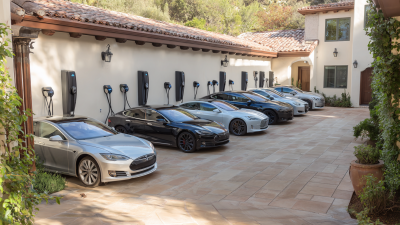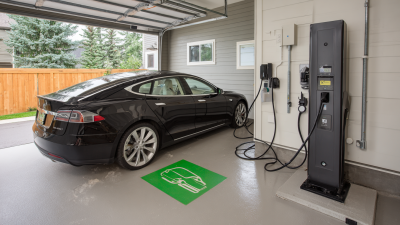In recent years, the Electric Charging Business has emerged as a critical component in the evolution of urban mobility. As cities around the globe strive to reduce carbon emissions and promote sustainable transportation, electric vehicle (EV) infrastructure has become paramount. Industry expert Dr. Emily Carter, a leading voice in electric mobility solutions, aptly stated, “The future of urban transportation hinges on our ability to innovate and expand electric charging networks that cater to the growing demand for clean energy vehicles.”
This insight underscores the urgency for transformative business innovations within the sector. As urban environments continue to adapt to the influx of electric vehicles, there is a pressing need for creative solutions in charging infrastructure, such as wireless charging, smart charging stations, and new payment models. These innovations not only enhance the user experience but also support the overall efficiency of urban mobility systems.
The Electric Charging Business stands at the forefront of this transformation, driving forward the integration of technology and sustainability. As we explore the future of this industry, it becomes clear that strategic advancements will play a pivotal role in shaping the urban landscapes of tomorrow.

Urban electric vehicle (EV) charging solutions are rapidly evolving, with innovative approaches emerging to enhance mobility in cities. Recent developments indicate a strong growth trajectory, with the electric vehicle DC market projected to reach USD 25 billion by 2035, showcasing a compound annual growth rate (CAGR) of 19.2% during this period. This surge is attributed to the rising demand for fast-charging infrastructure, which significantly reduces charging times and supports the increased adoption of electric vehicles.
Partnerships are key in pioneering new charging technologies. The collaboration between various stakeholders, such as city councils and private firms, has led to initiatives like the installation of curb chargers in Cologne and comprehensive charging infrastructures in cities like Newport. Furthermore, mobile charging solutions are gaining traction, enhancing the accessibility of charging stations and addressing urban mobility challenges. As cities commit to sustainable transport, these innovative charging solutions are poised to redefine the urban landscape, making electric mobility not just a possibility, but a practical reality for all residents.
| Charging Solution Type | Location | Charging Speed (kW) | Payment Method | User Accessibility |
|---|---|---|---|---|
| Fast Charging Station | Public Parking Lots | 150 kW | Mobile App | 24/7 Access |
| Slow Charging Point | Residential Areas | 7 kW | RFID Card | Limited Hours |
| Wireless Charging Pad | Corporate Offices | 11 kW | Subscription | By Appointment |
| Rapid Charging Network | Highway Rest Stops | 350 kW | Contactless Payment | 24/7 Access |
As urban areas increasingly adopt electric vehicles (EVs), the expansion of public charging infrastructure becomes vital to support this shift. According to a 2023 report by the International Energy Agency (IEA), there were over 1.8 million public EV charging points worldwide, marking a 60% increase from the previous year. However, to keep pace with rising EV adoption, the IEA suggests that the global network of publicly available chargers needs to triple by 2030.
Strategies to expand this infrastructure must focus on accessibility and user experience. Implementing a mix of fast chargers in strategic locations, enhancing payment options, and incorporating renewable energy sources can create a more appealing charging ecosystem. For instance, cities could leverage partnerships with private sectors and use data analytics to identify high-demand areas, optimizing charger placement.
Tips: Municipalities should consider incentivizing private investments in charging stations by providing grants or tax breaks. Collaborating with technology companies can also enhance the efficiency of the charging network through smart grid solutions that monitor usage patterns and manage energy loads effectively. Additionally, public awareness campaigns can educate drivers on charging options, improving overall accessibility.
The integration of renewable energy sources into electric charging stations is an essential step towards a sustainable urban mobility future. By harnessing solar, wind, and other renewable energies, charging stations can significantly reduce their carbon footprint and operating costs. For instance, solar panels installed at charging stations not only provide clean energy to power the chargers but can also store excess energy in batteries for later use, enhancing efficiency and reliability during peak demand hours.
Moreover, incorporating smart grid technology allows these stations to optimize energy usage dynamically. When renewable energy generation is high, charging stations can operate at full capacity, while during lower production periods, the usage can be adjusted accordingly. This synergy not only contributes to a greener transportation ecosystem but also promotes energy independence and resilience. As cities embrace innovations in electric charging infrastructure, the collaboration between urban planners, energy suppliers, and technology developers will be crucial in creating a robust network of renewable-powered charging solutions.
The electric vehicle (EV) charging landscape is rapidly evolving, driven by innovative mobile applications and advanced payment systems that enhance user experience. According to a recent report by McKinsey, the global market for EV charging infrastructure is projected to reach $140 billion by 2030, indicating a substantial shift towards electrified urban mobility. Smart apps are at the forefront of this transformation, enabling users to locate charging stations, check availability in real-time, and navigate seamlessly to their destination. These technologies cater to the growing demand for convenience and efficiency experienced by urban drivers.
In addition to navigation and real-time updates, enhanced payment systems are reshaping how users interact with charging stations. A report from Bloomberg New Energy Finance noted that over 60% of EV owners prefer contactless payment options, making it essential for charging networks to adopt user-friendly transaction solutions. Integrating mobile wallet capabilities and subscription services not only simplifies the payment process but also encourages the adoption of electric vehicles. As urban mobility continues to evolve, the advancement of smart apps and payment solutions will play a pivotal role in shaping a sustainable and user-centric electric charging experience.
Collaborative partnerships are vital in reshaping urban mobility towards a more sustainable future. The recent push for integrated cross-domain solutions emphasizes the need for cooperation across various sectors. For instance, strategic alliances can lead to the development of smart mobility initiatives that accommodate increasing urban populations. A notable example includes a partnership aimed at creating integrated transportation solutions to handle the influx of visitors in rapidly growing urban areas.
Moreover, the collaboration in micromobility options plays a crucial role in reducing car dependency and promoting sustainable transport methods within cities. By fostering shared mobility systems, urban planners can enhance the quality of life for residents while addressing environmental concerns. These partnerships not only promote innovative traffic management and efficiency but also position cities to implement zero-emission zones effectively.
Through continuous collaboration and data-driven methodologies, urban mobility can evolve to meet the challenges of modern city living while prioritizing sustainability.






